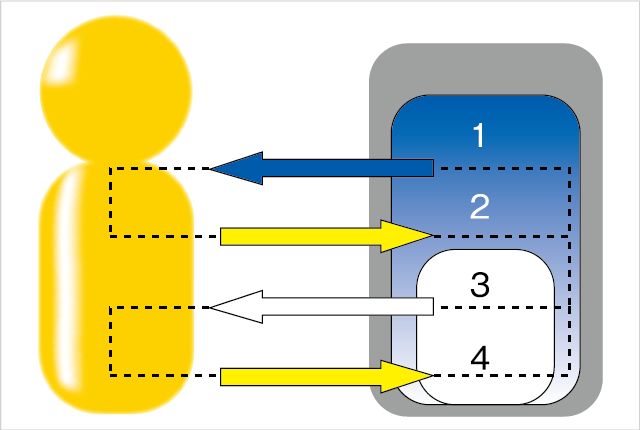THE MADE IN JAPAN "ELESAS" IS A PORTABLE MICROCURRENT THERAPY UNIT TO RELIEVE PAIN & RELEASE MUSCLE TENSION.
ElesAs
To Relieve Pain & Release Muscle TensionPortable Microcurrent Therapy Unit
What is the ElesAs?
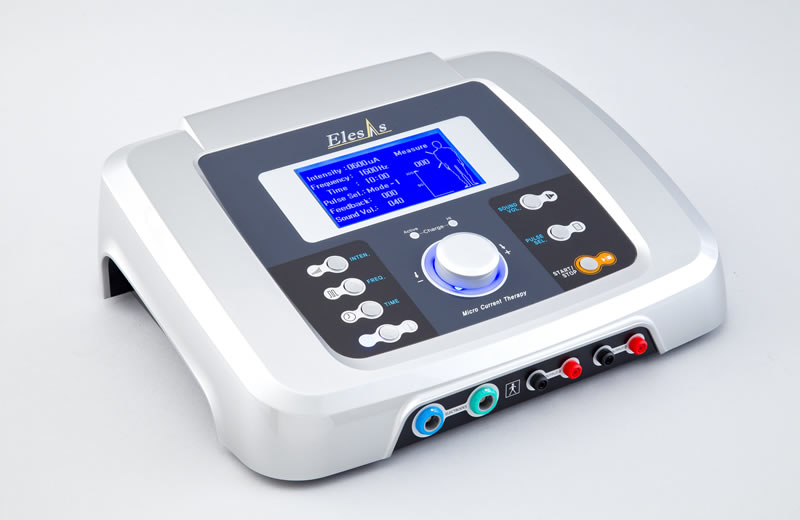
THE MADE IN JAPAN "ELESAS" IS A PORTABLE MICROCURRENT THERAPY UNIT TO RELIEVE PAIN & RELEASE MUSCLE TENSION.
The made in Japan "ElesAs" is a portable microcurrent therapy unit to recover one’s motor function. Unlike the other electrotherapy unit which uses a strong electricity and establishes the “gate control theory”,ElesAs uses microcurrent to relieve pain and swelling caused by injury to muscles, ligaments and tendons in sports.
How dose it work?
Damage to cell membranes or abnormalities in membrane potential, by injuries or overwork or stress etc., increases the internal impedance and reduces the tissue conductance. These results in the disruption of the body’s normal electrical balance. As shown on the left picture, to treat this disruption, ElesAs occurs a two-way communication.
This communication enables ElesAs to confirm the impedance value of the area treated by its own computer circuitry, and to the body it will introduce the needed gentle current, in waveforms. This communication is repeated until the impedance gets near the normal value.
The first set frequency and pulse value should be changed due to the result of the communication. The result, or by means the change of the impedance is shown by the feedback value; the higher the feedback the better the normalizing of the impedance. After the impedance is normalized, ElesAs will help to keep the normalized impedance value.
1.feedback current output
2.Input the internal impedance of the body
3.Waveform adjustment and output for input information
4.Input changed internal impedance
Repeat step 3-4 many times
Two way communication=Biofeedback system
Unlike the general mA electrotherapy device, "ElesAs" uses microcurrent(㎂) , the stimulation of it is 1/1000 of mA.
The weak stimulation produced from microcurrent will not suppress pain transmission, nor give the patient a sense of electrical stimulation, nor stimulate muscles.
Moreover, as ㎂ is very similar to the body's own electrical current, it makes the feedback from the affected area possible.
By this feedback system, ElesAs could confirm the abnormality and impedance value of the treated area and generate the current which is needed for the body.
When the impedance value and tissue conductivity is normalized, the electrical valance of the affected area will be normalized as well. When the electrical valance has improved the spontaneous remission is enhanced by the homeostasis reconstructed by communication between cells.
The waveform of ElesAs is made up from overshoot and Plateau waveform. The start of overshoot takes only 13㎲, this helps the normalization of the impedance end quickly.

fig.2 The current flowing through the plasma membrane changes the voltage by passing through the ion- permeable membrane (membrane resistance).

fig.3 The change of the membrane voltage, alters the voltage-dependent ion channel existing in the membrane.

fig.4 When the cell membrane is damaged, intracellular potassium ions and ATP are released, and conversely, extracellular calcium ions and sodium ions flows in, causing abnormal potential.

For an early cure
Summary
Mode1(biphasic) enhances cell metabolism by supplying electricity to the inside of cells, and Mode2(monophasic)normalizes the potential difference by supplying electricity to outside of cells.
In the acute phase, use Mode 1 to help self-repairing by enhancing the cell metabolism. In the chronic phase, as the action potential decreases, firstly use Mode2 to make the potential difference normalize, and after using Mode 2 use Mode1.
Mode-1
mode-1 mechanism restores ion channels and membrane potential by promoting cellular metabolism and normalizing tissue potential. Normalized and stabilized cells can help reduce swelling due to injury, repair tissue, and alleviate hypertonia due to excessive exercise.
Mode-2
Mode-2 normalizes cell-to-cell communication by normalizing the potential difference between the inside and outside of the cell, which is disturbed by tissue damage. Used to improve cell arousal, repair, and neurotransmission.
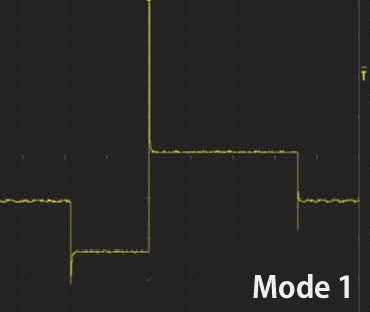
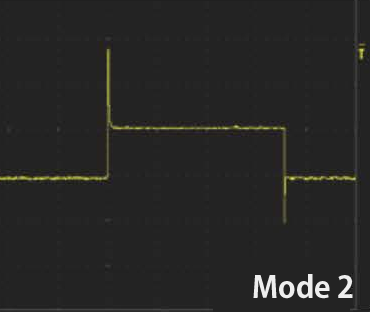
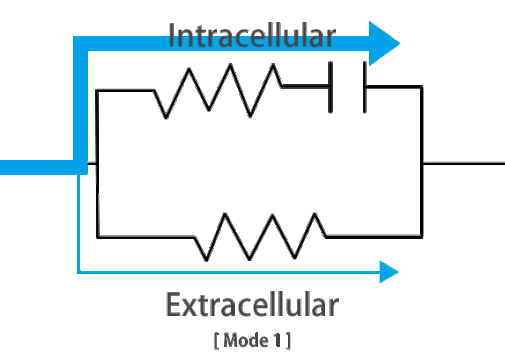
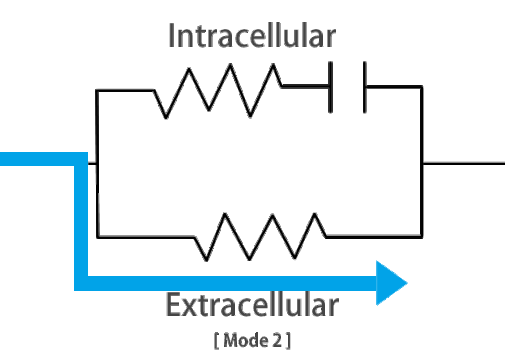
As the cells and the external environment of the body are prepared and the homeostasis is reconstructed, the healing speed is improved by 30% or more compared to he conservative therapy as shown left. As a result, the pain is immediately reduced or eliminated.
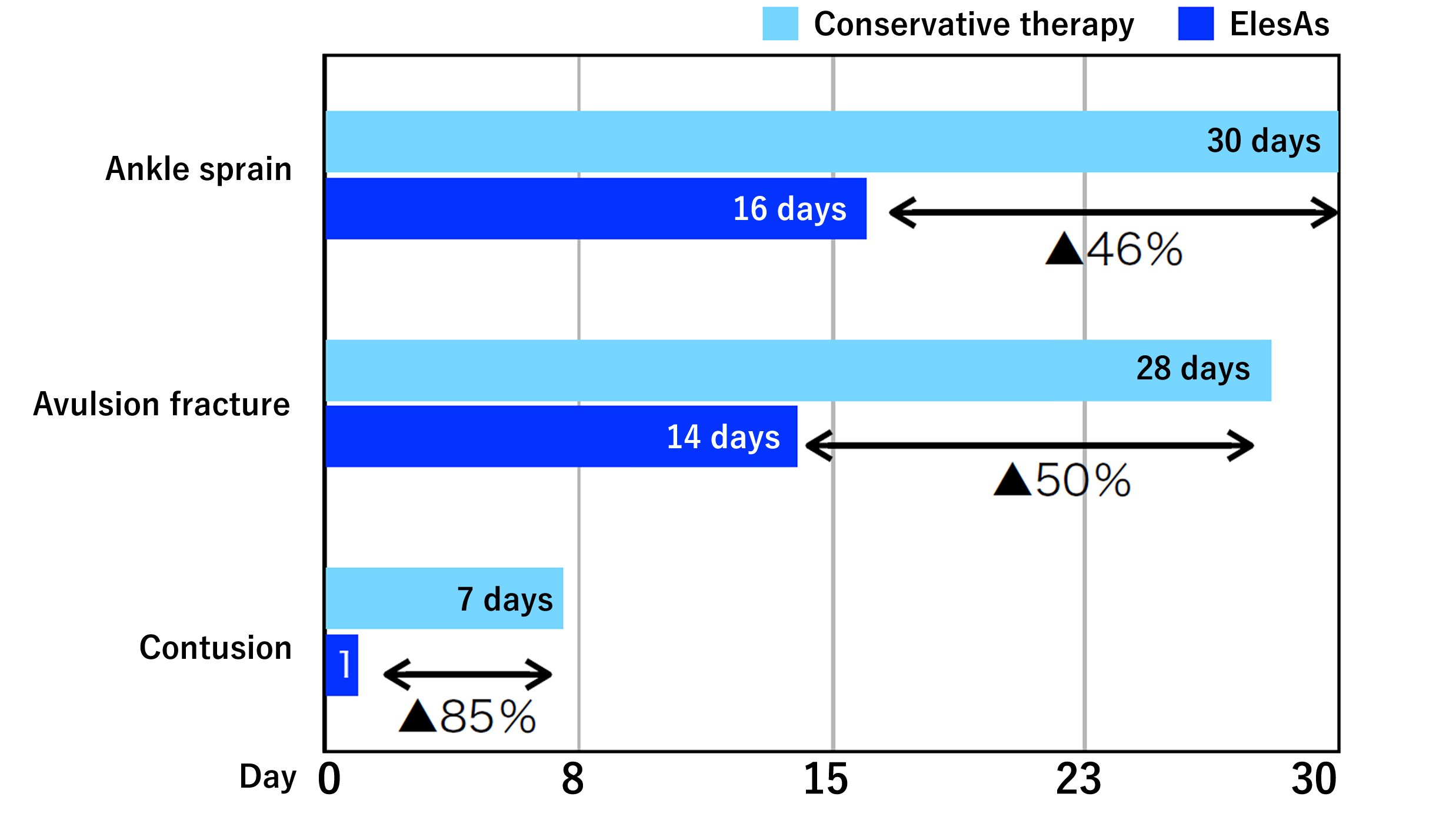
How to use ElesAs
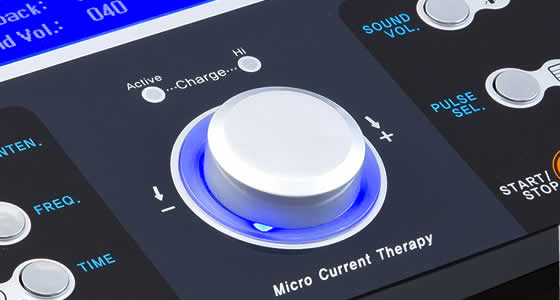
To make the desired settings, simply turn the center push dial. All operations can be performed smoothly with one fingertip, so the therapist can concentrate on the treatment.
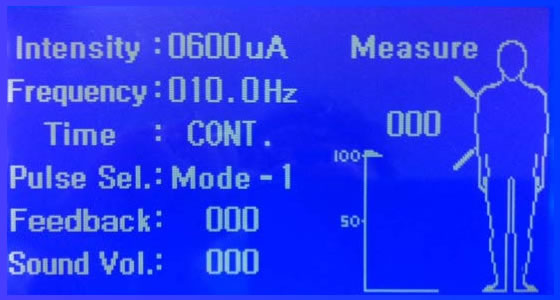
Intensity
Frequency Time:Treatment time
Pulse Sel.: Mode switching
Feedback: Feedback value
Sound Vol.
Technical Specifications
| Device Name | Elesas |
|---|---|
| Certificate No. | 222ACBZX00085000 |
| Category of Device | Medical Device / Electro stimulation |
| Country of Origin | JAPAN |
| Inlet Power | 100-240 V via adopter |
| Rechargeable Batteryd | Ni-MH Rechargeable Battery Model: HR-3UTGA, Capacity 2.0 Ah, Normal Voltage: 1.2 V |
| Output | 0.6 mA, 1.2 V |
| Frequency | 0.3, 1.0, 2.0, 2.5, 4.0, 8.0, 10, 20, 40, 80, 100, 160, 320, 400, 800,1600, 2000 Hz ±30% and AUTO |
| Timer | 4, 6, 8, 12, 16, 30 secs, 1, 3, 5, 10, 15, 20 mins and Cont. ±10% |
| Dimensions | 365×300×110 mm |
| Weight | 4.4kg |
| Technical Approval | IS T0601-1 (equivalent to EN DIN60601-1) JIS T0601-1-2 (equivalent to EN DIN60601-1-2) JIS T0601-1-10 (equivalent to EN DIN60601-2-10) |
【Note】Physical electrotherapy equipment
A typical electrotherapy device uses mA current to suppress pain transmission and stimulate muscle movement. The pain transmission is suppressed by changing the excited pain gate to inhibitory, with stimulating the gate by electrical stimulation to the nerve in the affected or nearby area faster than the pain signal. (This is the called “Gate Control Theory”) Muscle movement stimulation increases the amount of current. The blood flow increases when muscle pumping and re-education are performed by contracting the muscle passively by electrical stimulation. The repair speed of tissues involved in healing varies depending on the age and activity level.



